The Medusa Nebula (Sh2-274) is a large planetary nebula located 1,500 light-years away in the constellation Gemini. With an apparent magnitude of 15.99, the nebula is a challenging target for amateur telescopes. It occupies an area 10.25 arcminutes across and has a physical diameter of about 4 light-years.
The nebula was named after the Gorgon Medusa, a hideous creature from the myth of Perseus. In Greek mythology, Medusa was one of the three Gorgon sisters, monstrous creatures with living snakes in place of hair. Medusa’s hair is represented by the serpentine filaments formed by the nebula’s gas.
Like other planetary nebulae, the Medusa was formed by an intermediate to low-mass red giant star that shed its outer layers in the late stage of its evolutionary cycle. The remnant stellar core is causing the expanding shell of ionized gas to brightly fluoresce.
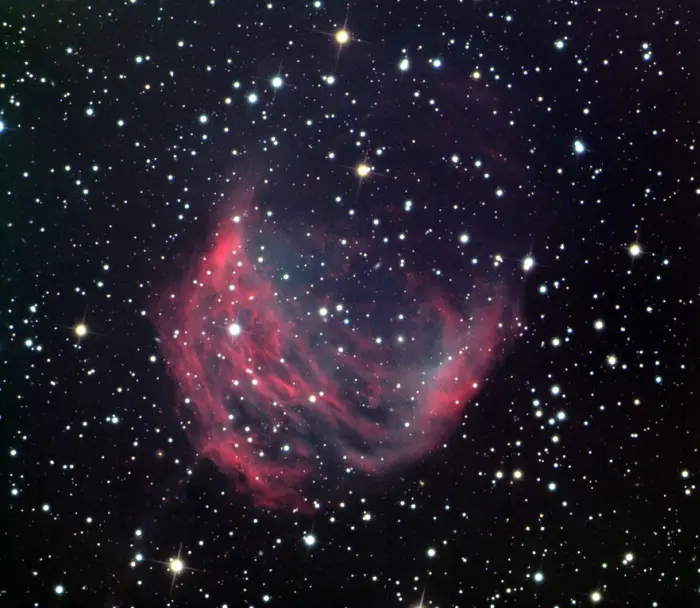
Medusa Nebula (Abell 21), image: Wikimedia Commons/ Jschulman555 (CC BY 3.0)
Planetary nebulae are formed by stars that are not massive enough to go out as supernovae at the end of their life cycle. After a star passes through the asymptotic giant branch (AGB), it loses material at speeds of a few kilometres per second. The expelled material forms the nebula’s distinctive structure. The hot star at the core of the nebula loses most of its hydrogen envelope, leaving behind an electron-degenerate carbon-oxygen core.
At this stage of their evolution, stars intermittently expel clouds of material, and the ejection of mass results in complex structures lit by the central stars.
As the gaseous material speeds away from the central star, the star first grows hotter and then gradually cools as it exhausts its hydrogen shell. As the star grows hotter, it emits more ultraviolet light. The harsh ultraviolet radiation from the hot star ionizes the surrounding cloud of gas, causing atoms to lose their electrons.
When stellar cores of planetary nebulae cool, they become white dwarfs that do not give off enough energy to illuminate the surrounding nebulae. At the same time, the clouds of gas gradually disperse into their surroundings. At this point, the nebulae become invisible to us, and the white dwarfs continue to fade for trillions of years.
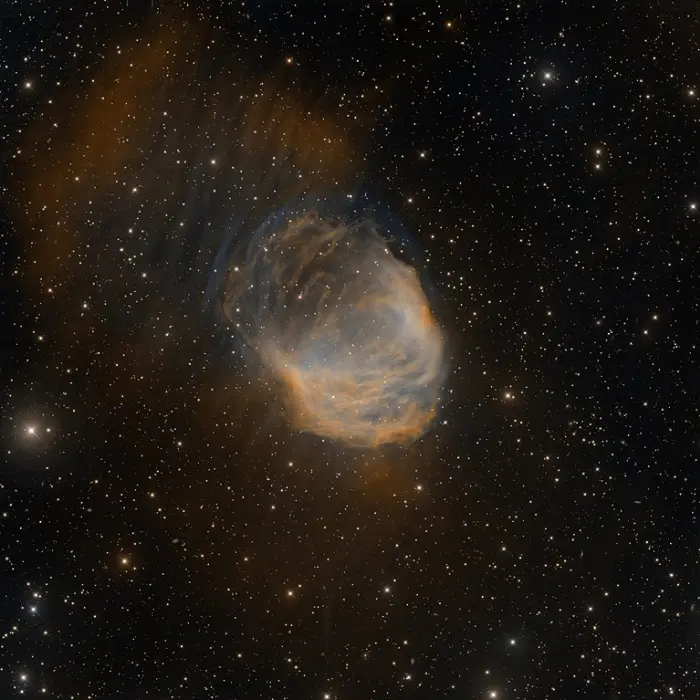
Medusa Nebula, image credit: T. A. Rector/University of Alaska Anchorage and H. Schweiker/NOIRLab/NSF/AURA and NOIRLab/NSF/AURA (CC BY 4.0)
The planetary nebula is the final stage in the transformation of stars as they end their active lives and become white dwarfs. Our Sun itself will form one in the last phase of its evolution, in about 5-6 billion years.
The stellar core of the Medusa Nebula is a PG 1159 star, transitioning from being the central star in the planetary nebula to being a hot white dwarf. PG 1159 stars are pre-degenerate stars with hydrogen-deficient atmospheres and surface temperatures between 75,000 K and 200,000 K.
In the life of a star, the planetary nebula stage only lasts about 10,000 years, a tiny fraction of its total life span. The estimated age of the Medusa is 8,800 years.
In 2015, astronomers at the European Southern Observatory (ESO) captured a detailed image of the nebula’s glowing gas using the Very Large Telescope (VLT) in the Atacama Desert in northern Chile. The image shows the red glow from the hydrogen gas and a fainter green emission from oxygen gas, which together form the nebula’s crescent shape. The nebula extends well beyond the frame.
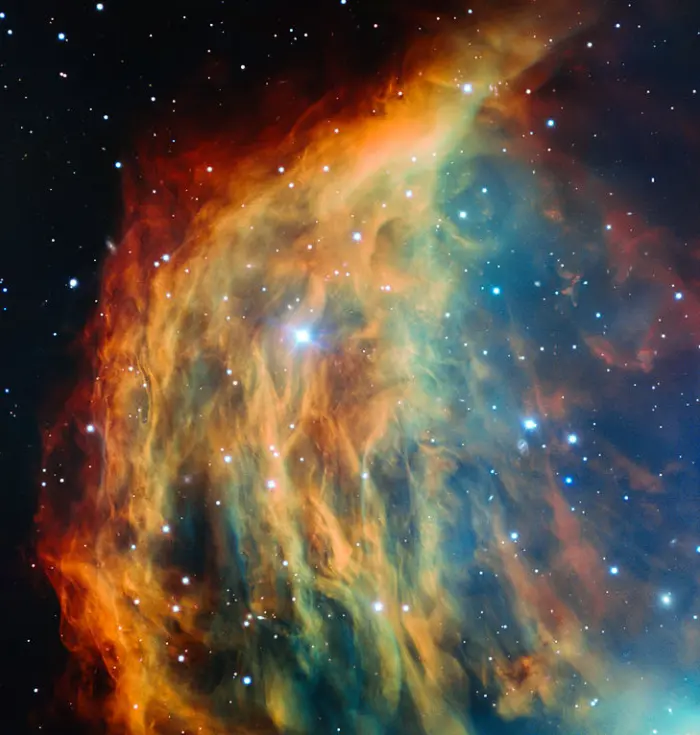
ESO’s Very Large Telescope in Chile has captured the most detailed image ever taken of the Medusa Nebula (also known Abell 21 and Sharpless 2-274). As the star at the heart of this nebula made its final transition into retirement, it shed its outer layers into space, forming this colourful cloud. The image foreshadows the final fate of the Sun, which will eventually also become an object of this kind. This image uses data from the FOcal Reducer and low dispersion Spectrograph (FORS) instrument attached to the VLT, which were acquired as part of the ESO Cosmic Gems programme. Credit: European Southern Observatory
The bright star visible in the center of the image is not Medusa’s central star. It is a foreground star, located much closer to us than the nebula. The star is catalogued as TYC 776-1339-1. The nebula’s central star is a dimmer, bluish star appearing in the right-hand part of this image, off-centre of the crescent shape. It is catalogued as WD0726+133.
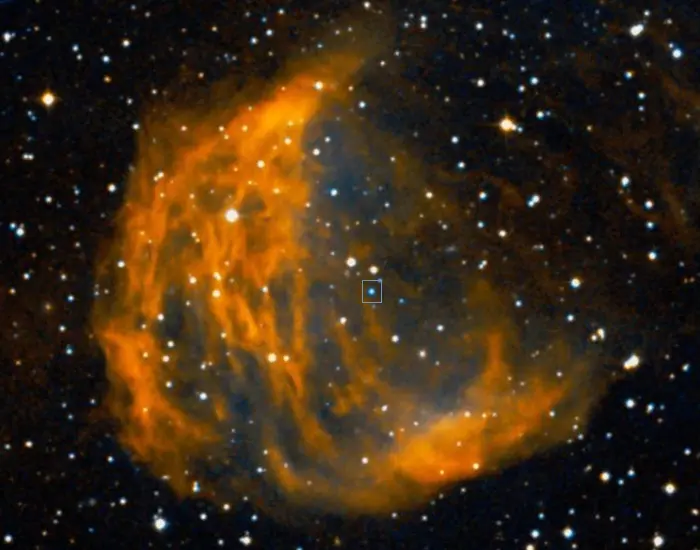
The location of WD0726+133, the central star of the Medusa Nebula, image: Wikisky
Facts
When green emission lines were first observed in the 19th century, for some time scientists thought that a new element, named nebulium, was responsible for the emission. The green emission was discovered by the English astronomer William Huggins while observing the Cat’s Eye Nebula (NGC 6543) in Draco in 1864.
Nebulium was relatively short-lived. In 1927, American physicist and astronomer Ira Sprague Bowen showed that it was in fact a rare wavelength of radiation from doubly ionized oxygen (O III or O2+) that explained the presence of the green glow. Astronomers can isolate the emission using appropriate filters to make the dim nebulae stand out against a darker background.
The Medusa Nebula was discovered by the American astronomer and educator George O. Abell in 1955. Abell classified the object as an old planetary nebula. The Medusa is also known by the catalogue designation Abell 21 from the Abell Catalog of Planetary Nebulae (1966) and Sharpless 2-274, from the Sharpless catalogue of H II regions.
The Medusa Nebula was believed to be a supernova remnant until the 1970s. In 1971, a team led by T. A. Lozinskaya of the Sternberg Astronomical Institute in Moscow carried out a series of interferometric observations in order to analyze the internal motions and other properties of the material in the nebula. Lozinskaya found that the nebula was expanding at a velocity of 53 ± 10 km/s. The expansion velocity and radio emission indicated that Abell 21 was a planetary nebula, not a supernova remnant.
Location
The Medusa Nebula lies in the constellation of Gemini, near the border with Canis Minor. It can be found roughly a quarter of the way from Gomeisa in Canis Minor to Castor, the second brightest star in Gemini. It appears near the magnitude 3.6 star Lambda Geminorum, in the same area of the sky as the brighter planetary nebula NGC 2392.
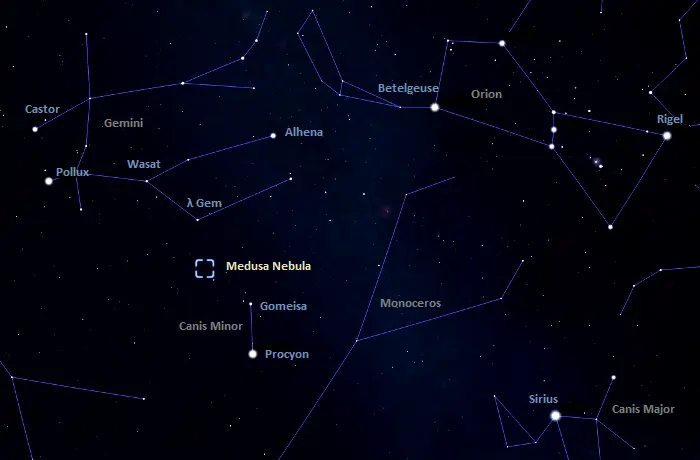
The location of the Medusa Nebula, image: Stellarium
The best time of the year to observe the Medusa Nebula and other deep sky objects in Gemini is during the month of February, when the celestial Twins rise high above the horizon in the evening. Due to its large size, the nebula has a low surface brightness and is a difficult target in less-than-ideal conditions. It is best seen in a large telescope with an OIII filter.
Medusa Nebula – Sharpless 2-274
| Constellation | Gemini |
| Right ascension | 07h 29m 02.7096654190s |
| Declination | +13° 14′ 48.587555198″ |
| Apparent magnitude | 15.99 |
| Absolute magnitude | 7.68 |
| Apparent size | 10.25 x 10.25 arcminutes |
| Radius | 4 light-years |
| Distance | 1,500 light-years (460 parsecs) |
| Names and designations | Medusa Nebula, Sharpless 2-274, Sh2-274, Abell 21, PK 205+14 1, ARO 388, PN G205.1+14.2, PN A66 21 |